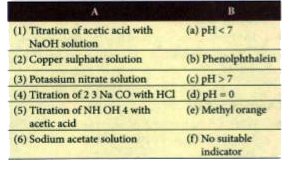Complete Solutions to Consolidated Exercise of chapter ACIDS, BASES AND SALTS of Class 9 book with complete answers and questions
| Class 9 | CHEMISTRY |
| Chapter | ACIDS, BASES AND SALTS |
| CENGAGE CHEMISTRY | Consolidated Exercise |
| Number Of Questions | 5 |
| Academic Year | 2023-24 |
Strengths of Acids and Bases Greater the number of `H^(+)` ions produced in the aqueous solution, stronger is the acid. Similarly, greater the number of `OH^(-)` ions produced in the aqueous solution, stronger is the base. The relative strength of two weak acids can, however, be compared in a quantitative manner as explained below:
Suppose the weak acid is represented as HA. Let the initial concentration of HA be C mol/L and a be its degree of dissociation. Thus,
`{:(,"HA + water",hArr,H_((aq))^(+)+,A_((aq))^(-),),("In C"," " C,,O,O,),(," "C-C alpha,,C alpha,C alpha,),(,=C (1-alpha),,,,):}`
Applying the law of chemical equilibrium, `k_(a) = `k_(a) = ([H_((aq))^(+)][A_((aq))^(-)])/([HA])`
where `k_(a)` is called as dissociation constant of the acid. Degree of dissociation `(alpha)` of a weak acid is very small. Therefore, `1 - alpha ~= 1`
`k_(a) = (C alpha.C alpha)/(C(1-alpha)) = (C alpha^(2))/(1-alpha) ~= C alpha^(2)` or `alpha = sqrt((k_(a))/(C))`
Thus, if two acids of equimolar concentration are taken (so that C is constant).
`(alpha_(1))/(alpha_(2)) = sqrt((k_(a_(1)))/(k_(a_(2))))`
Thus, the relative strengths of two acids of equimolar concentration can be compared by taking the square root ratio of their dissociation constants.
Similarly, for relative strengths of two weak bases,
`(alpha_(1))/(alpha_(2)) = sqrt((k_(b_(1)))/(k_(b_(2))))`
The strength of acids and bases can be experimentally determined by the pH meter.
Which one is a stronger acid: `CH_(3)COH` or HCN ?
(`k_(a)` for `CH_(3)COOH = 1.8 xx 10^(-5), k_(a)` for `HCN = 4.9 xx 10^(-10)`)
View SolutionWhich of the following bases are stronger and by how much?
`NH_(3)` and `NH_(2)OH`
`(k_(b(NH_(3))) = 1.77 xx 10^(-5), k_(b(NH_(2)OH)) = 1.1 xx 10^(-8))`
View SolutionWhich of the following bases are stronger and by how much?
`N_(2)H_(4)` and `CH_(3)NH_(2)`
`(k_(b(N_(2)H_(4))) = 1.7 xx 10^(-6), k_(b(CH_(3)NH_(2))) = 3.7 xx 10^(-4))`
View SolutionWhich of the following bases are stronger and by how much?
`C_(2)H_(5)N` and `C_(6)H_(5)NH_(2)`
`(k_(b(C_(2)H_(5)N)) = 1.77 xx 10^(-9), k_(b(C_(6)H_(5)NH_(2))) = 4.27 xx 10^(-10))`
View SolutionMatch the following:

View Solution
Consolidated Exercise questions and complete solutions for chapter ACIDS, BASES AND SALTS of CENGAGE CHEMISTRY of Class 9